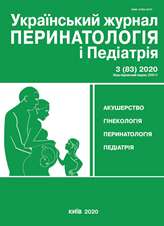Air pollution and health of children in Ukraine
DOI:
https://doi.org/10.15574/PP.2020.83.31Keywords:
children, morbidity, prevalence, mortality, air pollutionAbstract
Atmospheric air pollution is one of the main factors, which negatively affects the health of children in Ukraine. It can exacerbate chronic diseases and decrease the quality of life of children and their families.
The aim to determine the correlation ranking between the incidence and prevalence of diseases among children in Ukraine in 2015 and the volume of pollutant emissions from stationary and mobile sources of pollution per person depending on the area of residence.
Materials and methods. During the analysis, data from the Center for Medical Statistics of the Ministry of Health of Ukraine and the State Statistics Service of Ukraine for 2015 were used. Methods of system approach, epidemiological, correlation and cluster analysis are applied.
Results. In our study we have discovered that the volume of pollutant emissions from stationary and mobile sources into the atmosphere per 1 person had a direct impact on the incidence of all diseases of children in Ukraine, especially children aged 0–6 years (p<0.01). The closest direct correlation was observed between pollutant emissions and prevalence of respiratory diseases among children, especially in children aged 0–6 years and 15–17 years and with the prevalence of bronchial asthma and diabetes in all age groups. The correlation between children morbidity level of tuberculosis, some infectious and parasitic diseases, congenital anomalies, circulatory and digestive diseases, diseases of the musculoskeletal system, ear and mammary gland and the volume of air toxic emissions haven't reached any important statistical significance. Correlation between the mortality rates of children under one year and the incidence of all diseases, including respiratory diseases, some infectious diseases, acute respiratory viral infections, pneumonia and influenza, cerebral palsy and air toxic emissions also haven't reached statistical significance.
Conclusions. Morbidity and prevalence of all children's diseases was chained in different manner with the amount of pollutant air emissions. This fact indicates that the increase in morbidity is associated not only with socio-economic and medical and genetic factors, but also with environmental influence. This situation requires brings a necessity of establishment the issue of environmental safety of the population of Ukraine, especially children.
References
Antypkin YuG, Reznichenko YuG, Yartseva MO. (2012). Influencing of the environmental factors on the status of healthy children of early age. Perinatology and Pediatrics. 1 (49): 48–51. URL: http://medlib.dp.gov.ua/jirbis2/images/fond_publications/perinatologiya-ipediatriya/perinatologiyaipediatriya_2012_1.pdf.
Dudina OO, Gaborets YuYu, Voloshina UV. (2015). To the health of the child population. The Health of the nation. 3: 10–11.
Environment of Ukraine. (2015). Statistical yearbook. State Statistics Service of Ukraine. Kyiv: 242.
European Environment Agency/WHO Regional Office for Europe. (2002). Children's health and environment. A review of evidence. EEA. Copenhagen: 227. ISBN 92-9167-412-5.
Gehring U, Gruzieva, O, Agius RM, Rob Beelen et al. (2013, Nov–Dec). Air Pollution Exposure and Lung Function in Children: The ESCAPE Project. Environ Health Perspect. 121 (11–12): 1357–1364. https://doi.org/10.1289/ehp.1306770; PMid:24076757 PMCid:PMC3855518.
Grebnyak MP, Shchudro SA. (2010). Ecology and health of children: risk factors, epidemiology. Dnepropetrovsk. Porogi: 95.
Khilko MI. (2006). Ecological safety of Ukraine: in questions and
answers. Kyiv: Knowledge of Ukraine: 144.
Lyapkalo AA, Dementiev AA, Tsurgan AM. (2014). Influence of atmospheric air quality on the incidence of children in the city. Modern problems of science and education: 3. URL: http://www.science_education.ru/ru/article/view?id=13409.
Moiseenko RO, Dudina OO, Goyda NG. (2017). Analysis of the incidence and prevalence of diseases in children in Ukraine for the period 2011–2015. Sovremennaya pediatriya. 2 (82): 17–27. https://doi.org/10.15574/SP.2017.82.17.
Nisbet R, Miner C, Yale K. (2018). Handbook of Statistical Analysis and Data Mining Applications. Second Edition. Academic Press: 1–795. ISBN 978-0-12-416632-5.
Provision of medical care to children aged 0–17 in health care institutions located in the sphere of management of the Ministry of Health of Ukraine: statistical_analytical reference book. Edited VM Zabolotko. (2020).
Pruss–Ustun A, Wolf J, Corvalan C, Bos R, Neira M. (2017). Preventing disease through healthy environments: a global assessment of the burden of disease from environmental risks. Geneva: World Health Organization. URL: http://www.who.int/iris/handle/10665/204585.
Schwartz J. (2004, Apr). Air pollution and child health. Pediatrics. 113 (4): 1037–1043. PMID: 15060197.
Serdyuk AM, Stus VP. (2011). Ecology of the environment and safety of life of the population in the industrial regions of Ukraine. Dnipropetrovsk: Porogi: 486.
Tamburlini G. (2006). New developments in children's environmental health in Europe. Annals New York Academy Science. 9: 691–702. URL: https://doi.org/10.1196/annals.1371.053; PMid:17119246.
Volosovets OP, Kryvopustov SP, Volosovets TM, Abaturov OE, Kryuchko TO. (2019). Changes in health status of child population of Ukraine after Chernobyl catastrophe. Wiadomosci Lekarskie. LXXII (10): 1974–1976. https://doi.org/10.36740/WLek201910123; PMid:31982025.
WHO. (2018). Air quality and health. URL: https://www.who.int/ru/news-room/fact-sheets/detail/ambient-(outdoor)-air-quality-and-health/.
WHO. (2018, Aug). Air pollution and child health: prescribing clean air. Summary. Geneva. License: CC BY-NC-SA 3.0 IGO. URL: http://www.who.int/airpollution/data/cities/en/.
WHO. (2018, May 2). Burden of disease from the joint effects of household and ambient air pollution for 2016. URL: https://www.who.int/airpollution/data/AP_joint_effect_BoD_results_May2018.pdf?ua=1.
Downloads
Published
Issue
Section
License
The policy of the Journal “Ukrainian Journal of Perinatology and Pediatrics” is compatible with the vast majority of funders' of open access and self-archiving policies. The journal provides immediate open access route being convinced that everyone – not only scientists - can benefit from research results, and publishes articles exclusively under open access distribution, with a Creative Commons Attribution-Noncommercial 4.0 international license(СС BY-NC).
Authors transfer the copyright to the Journal “MODERN PEDIATRICS. UKRAINE” when the manuscript is accepted for publication. Authors declare that this manuscript has not been published nor is under simultaneous consideration for publication elsewhere. After publication, the articles become freely available on-line to the public.
Readers have the right to use, distribute, and reproduce articles in any medium, provided the articles and the journal are properly cited.
The use of published materials for commercial purposes is strongly prohibited.

